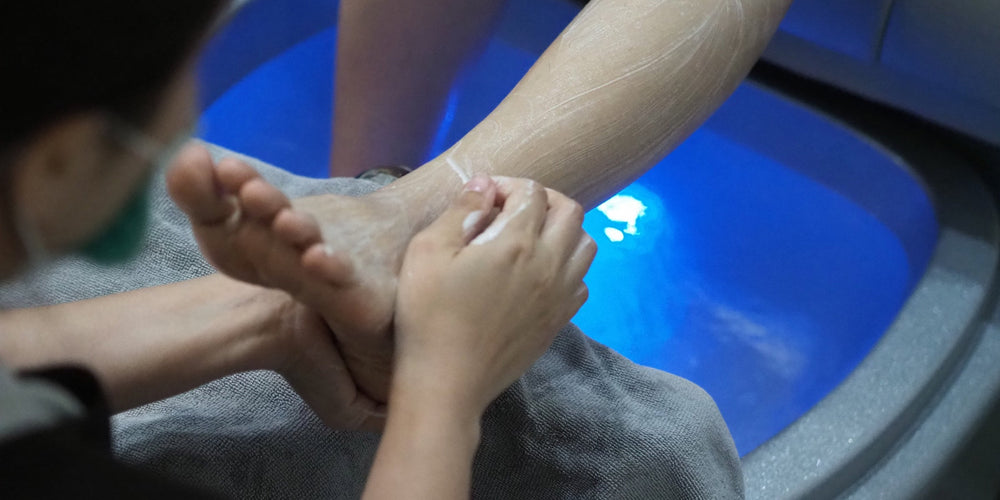Diabetic Foot Care at Home: 5 Simple Techniques for Optimal Foot Health

Stay tuned to our latest news
So, let’s explore five simple techniques that you can incorporate into your daily routine to ensure the well-being of your feet. By following these practices, you can reduce the risk of infections, ulcers, and other foot-related issues, ultimately improving your overall quality of life. So, let's dive in and discover how you can take proactive steps to care for your feet from the comfort of your own home.
Why Diabetic Foot Care at Home is Essential?

Diabetic foot care is of utmost importance for individuals with diabetes to prevent potentially severe complications. Managing foot health at home requires proper education, vigilance, and an understanding of the unique risks faced by individuals with diabetes. Neglecting foot care can lead to serious conditions such as ulcers, infections, and even amputation. Therefore, it is crucial to prioritize diabetic foot care at home to maintain overall health and prevent long-term complications.
5 Diabetic Foot Complications You Need to Know
Diabetic foot complications are a major concern for individuals with diabetes. It is crucial for them to be aware of these complications in order to effectively address their foot care. Here are five diabetic foot complications that everyone with diabetes should know:
- Foot Ulcers: Foot ulcers are open sores that develop on the feet due to poor blood circulation and reduced sensation caused by diabetes. These ulcers can become infected if not properly cared for, potentially leading to more serious complications.
- Diabetic Neuropathy: Diabetic neuropathy is a nerve damage condition common in individuals with diabetes. It can cause numbness, tingling, or a complete loss of sensation in the feet. Consequently, it may lead to foot injuries going unnoticed, increasing the risk of developing infections or ulcers.
- Peripheral Vascular Disease: Peripheral vascular disease affects blood vessels outside of the heart and brain. In individuals with diabetes, high blood sugar levels can damage these blood vessels, resulting in poor blood flow to the feet. This reduced circulation can impair wound healing and increase the risk of infections and ulcers.
- Infection: Due to reduced sensation and compromised blood flow, individuals with diabetes are more susceptible to infections. Once an infection occurs, it can spread rapidly due to the impaired immune response common in diabetes, potentially leading to severe complications such as sepsis.
- Surgical Intervention or Amputation: If any of the diabetic foot complications are left untreated or inadequately managed, they can progress to the point where surgical intervention or even amputation becomes necessary. This is a significant and life-altering consequence that diabetes patients must be aware of.
Why Is It Important to Maintain Healthy Feet?

Maintaining healthy feet is crucial as neglecting foot problems can lead to serious complications such as infections, ulcers, and even amputations. Our feet bear the weight of our entire body and any issues or infections in this area can significantly affect our overall mobility and quality of life.
When foot problems, such as blisters, calluses, or toenail infections, are left untreated, they can develop into open wounds that are susceptible to infection. For individuals with diabetes, foot ulcers are a particularly serious concern. Diabetes can lead to poor circulation and nerve damage, a condition known as diabetic neuropathy, which impairs the ability to feel pain, heat, or cold. As a result, individuals with diabetic neuropathy may not be aware of cuts or blisters on their feet, allowing these injuries to worsen and potentially become infected.
To prevent foot issues and reduce the risk of developing foot problems, especially for individuals with diabetes, several steps should be taken. Firstly, maintaining good foot hygiene by washing feet daily, thoroughly drying them, and moisturizing them with lotion can help prevent dryness and cracking. It is also important to regularly trim toenails straight across and avoid cutting too close to the skin to prevent ingrown toenails. Wearing comfortable, properly fitting shoes and socks is essential, as tight shoes or socks can cause blisters and irritation.
Individuals with diabetes should pay extra attention to foot care due to the risk of diabetic neuropathy. Regularly inspecting the feet for any cuts, sores, or redness is important, along with seeking medical attention for any abnormal symptoms. It is recommended that individuals with diabetes have regular foot examinations performed by a healthcare professional to detect any changes or problems early on.
Maintaining healthy feet is crucial for overall well-being and mobility. Neglecting foot problems can lead to serious complications, including infections, ulcers, and even amputations. By taking preventive measures and seeking extra medical care for diabetic feet, the risk of developing foot problems can be significantly reduced. It is important to prioritize foot health and seek professional help for any concerns to ensure optimal foot care.
5 Simple Techniques for Optimal Foot Health

Having healthy feet is essential for our overall well-being, as they enable us to move and carry out our daily activities. Neglecting foot care can lead to various foot problems and discomfort. Luckily, there are simple techniques that can help maintain optimal foot health.
-
Check Your Feet Daily
It is essential to check your feet daily for any signs and symptoms of potential problems. By doing so, you can address any issues early on and prevent them from escalating into more serious conditions. When examining your feet, be sure to be thorough and look for specific signs.
One common sign to check for is blisters, which appear as fluid-filled sacs on the surface of the skin. Blisters can be caused by friction or ill-fitting shoes. Cuts, sores, and swelling are also worth noting as they can indicate an injury or infection. Redness is another sign to look for, as it may suggest inflammation or increased blood flow to the area.
In addition to these signs, check for calluses, which are thickened areas of skin that develop from repeated pressure or friction. Ingrown toenails, where the nail grows into the surrounding skin, should also be monitored. These conditions can cause discomfort and potentially lead to infections if left untreated.
It is important to use a mirror or seek assistance from a caregiver or healthcare provider if you have difficulty seeing and examining your feet. Additionally, you can test the sensitivity of different foot areas using a soft fabric or feather, gently brushing it against your skin. If you notice any abnormal sensations or decreased sensitivity in specific areas, it may indicate nerve damage or neuropathy.
By regularly checking your feet for blisters, cuts, sores, swelling, redness, calluses, and ingrown toenails, and by using a mirror or seeking assistance when needed, you can proactively identify any issues and seek appropriate medical attention. This daily practice significantly contributes to maintaining the health and well-being of your feet.
-
Wash Your Feet Every Day
Washing your feet every day is crucial for maintaining good hygiene and preventing various foot problems. This becomes even more important if you have diabetes, as it can affect the circulation and nerve endings in your feet, leading to a higher risk of developing infections and other complications.
When washing your feet, it is essential to follow the proper technique to ensure thorough cleaning. Start by wetting your feet with warm water, then apply a mild soap or cleanser. Gently scrub the entire surface of your feet, including the soles, heels, and tops. Pay extra attention to cleaning between your toes, as this area tends to accumulate sweat and bacteria.
After rinsing off the soap, it is crucial to dry your feet thoroughly, especially between the toes, as excess moisture promotes the growth of fungi. Use a clean towel and pat your feet dry, ensuring that no moisture is left behind.
In addition to washing, there are other measures you can take to keep your feet dry. Using nonmedicated powder, such as talcum powder, can help absorb excess moisture and prevent fungal infections. It is also advisable to moisturize your feet regularly with foot cream or lotion to prevent dryness and cracking.
By practicing proper foot hygiene, including daily washing, thorough drying, and keeping your feet dry, you can reduce the risk of foot complications and maintain overall foot health. This is particularly crucial if you have diabetes, as it can help prevent serious infections or ulcers that can lead to more severe complications.
-
Get Regular Foot Check-Ups
Regular foot check-ups with a podiatrist are of utmost importance for individuals with diabetes. Diabetes can lead to various complications, including damage to the nerves and blood vessels in the feet, which can result in serious foot problems. By scheduling regular foot check-ups, individuals can ensure early identification and prompt treatment of any potential diabetic foot problems.
Podiatrists are highly trained specialists who focus on foot and ankle health. They have extensive knowledge and experience in diagnosing and treating foot conditions, particularly those associated with diabetes. During a foot check-up, podiatrists conduct a thorough examination of the feet, looking for signs of any complications, such as cuts, sores, infections, and changes in skin color or temperature.
Early identification of foot problems is crucial for individuals with diabetes, as it can help prevent the progression of complications that can lead to ulcers, infections, and even amputations. Podiatrists are equipped to provide expert advice tailored to the specific needs of individuals with diabetes. They can offer guidance on appropriate footwear, foot care routines, and overall foot health maintenance.
-
Be Careful When Cutting Your Toenails
When it comes to cutting toenails, caution is key to avoid injuries and potential complications. It may seem like a simple task, but if done improperly, it can lead to painful issues such as ingrown toenails. Therefore, it is essential to follow certain steps and precautions to ensure optimal nail care.
Before starting the toenail trimming process, it is important to wash the feet thoroughly. This helps to remove any bacteria or dirt that might be present. Using a nail brush, gently scrub the nails and the surrounding area. Once clean, dry the feet with a clean towel, ensuring that they are completely dry to prevent any moisture-related complications.
Now it's time to cut the toenails. Use a good quality pair of nail clippers specifically designed for toenails. Trim the nails straight across, avoiding rounded edges. Cutting them too short can be problematic, as it increases the chances of ingrown toenails. It is crucial to leave a small amount of white nails at the tip to maintain nail health.
-
Never Walk Barefoot
Walking barefoot may seem like a harmless act, but it is essential to avoid it due to the various risks associated with it. The background information highlights several reasons why going barefoot should be avoided. Firstly, walking without proper footwear increases the risk of cuts and abrasions on the feet. Sharp objects such as broken glass, nails, or rocks on the ground can cause severe injuries when stepped on directly. These injuries not only cause pain but also pose a risk of infection if left untreated.
Additionally, walking barefoot exposes the feet to various infections. Fungal infections like athlete's foot can easily spread through direct contact with infected surfaces. Bacteria and parasites, such as tetanus, hookworm, or plantar warts, can also be contracted by walking barefoot. These infections can cause discomfort, pain, and in some cases, lead to serious health complications if not properly treated.
Takeaway
Diabetic foot care is crucial for individuals with diabetes to prevent complications such as infections, ulcers, and amputations. High blood sugar levels can lead to nerve damage and poor blood circulation, making the feet more vulnerable to injuries and infections. Neglecting foot care can result in serious consequences, so it is essential to prioritize foot health at home.
To maintain healthy feet, individuals with diabetes should practice regular foot care routines. This includes daily foot inspections, washing feet with mild soap and warm water, keeping feet moisturized but avoiding excessive moisture between the toes, wearing comfortable and properly fitting shoes, and avoiding walking barefoot. It is also important to trim toenails carefully, seek professional foot check-ups regularly, and promptly address any foot concerns or abnormalities. By following these practices, individuals with diabetes can reduce the risk of foot complications and improve their overall foot health and quality of life.
Renpho Health Tips
-

Discovering Key Foot Reflexology Points for Holistic Wellness
April 22, 2024
Read more >
-

Step Lightly: The Top 5 Culprits Behind Leg and Foot Pain – And How to Step Away From the Ache
April 1, 2024
Read more >
-

A Guide to the Best Gift Ideas for Your Mom
May 11, 2023
Read more >
-

5 Exercises to Prepare Your Feet for Hiking
May 8, 2023
Read more >
-

Relieve Stress with Pilates: 5 Exercises to Try Today
April 3, 2023
Read more >


